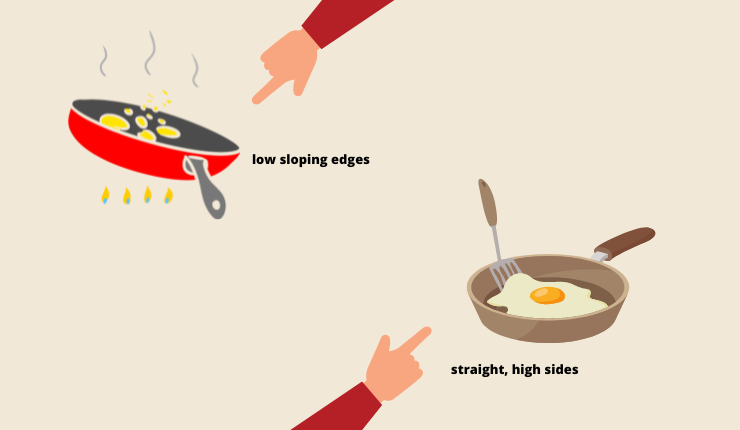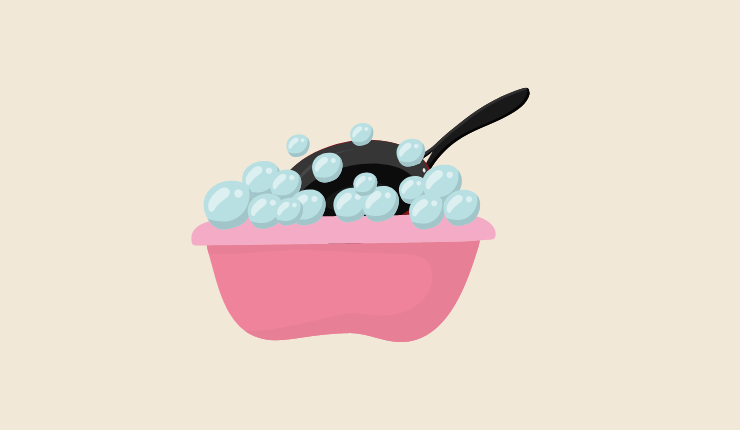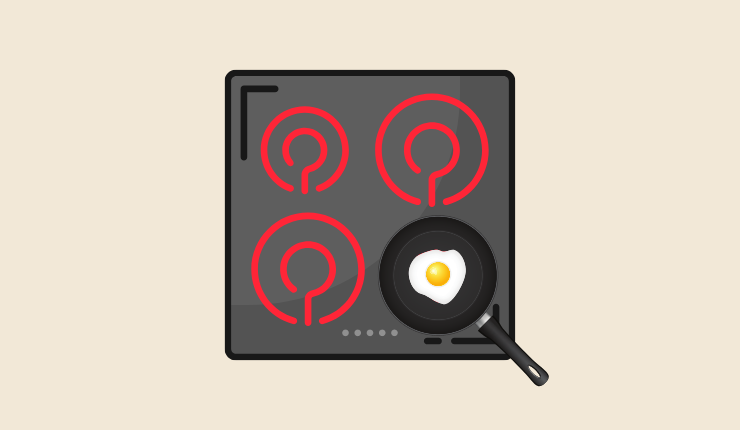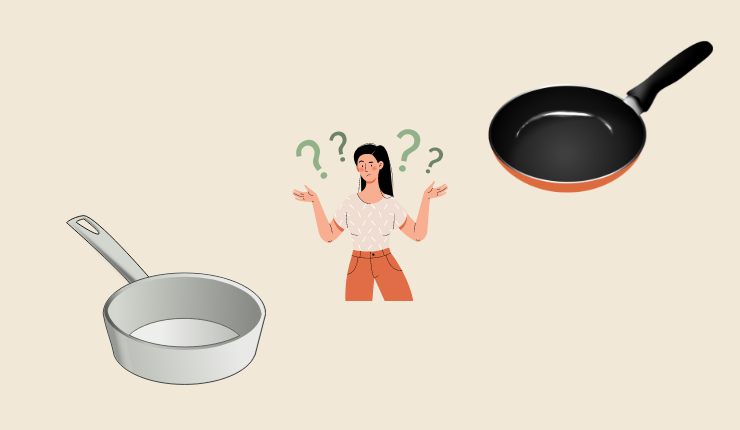Have you ever wondered about the difference between a fry pan and a French skillet? Though they both have their strong points, they’re not the same thing.
Every good chef should learn to recognize the pros and cons of their kitchenware. That way, you can make an informed decision about which utensil to use in any given situation.
When you’ve finished reading my Fry Pan vs French Skillet guide, you should know:
- How to identify fry pans and French skillets
- Which cooking applications are best suited for each one
- The best methods for cleaning these pans
- How long you can expect the pans to last
- Whether or not these pans can go in the oven
Even though cooking is a passion of mine, I didn’t know the difference between these two pans until I did a little bit of research. Since I was helped along the way by numerous forums that provided me with information about pricing and availability as well as the basics, I thought I would share what I’d learned by putting together this guide.
Heck, even if you consider frying pans to be weapons rather than cooking utensils, it’s always a good idea to learn about the weight and balance of the item, right?
Look, all I’m saying is I am the kinda girl who will cook you breakfast in the morning but may also smack you over the head with the fry pan. So really I’m a lover and a fighter 🤷♀️it’s all about balance.
— AMRicho1978 (@AMRicho1978) August 4, 2022
Table of Contents
- 1. Fry Pan vs French Skillet →
- 1.1. Size →
- 1.2. Shape →
- 1.3. Handles and Lids →
- 1.4. Materials →
- 1.5. Affordability →
- 1.6. Uses →
- 1.7. Coating →
- 1.8. Suggested Cooking Applications →
- 1.9. History →
- 1.10. Cleaning Recommendations →
- 1.11. Longevity →
- 1.12. Stovetop Compatibility →
- 1.13. Oven Safety →
- 2. Pros and Cons →
- 3. Are Fry Pans and French Skillets Interchangeable? →
- 4. Useful Resources →
Fry Pan vs French Skillet
Based on my personal experience as well as my extensive research, I was able to glean the following information about these utensils. Here’s a side-by-side comparison to quickly help you distinguish between the two:
| Frying Pan | French Skillet | |
|---|---|---|
| Size | 6-16 inches | 8-12 inches |
| Shape | Low sloping edges | Straight, high sides |
| Lid | Stainless steel, aluminum, ceramic | Stainless steel, cast iron |
| Shape | Less affordable | More affordable |
| Uses | Versatile, best for small amounts of food | Better at holding larger portions |
| Coating | More likely to have nonstick coating | Less likely to have nonstick coating |
This video also came in handy:
I hope you find this information as engaging and interesting as I do!
Size
While a frying pan may measure anywhere from 6 to 16 inches, French skillets are typically available in a narrower range. 8 to 12 inches is the standard size range for a French skillet.
If you’re just looking to toast a few nuts for a recipe or fry a single egg, it’s probably better to reach for a small fry pan. On the other end of the spectrum, your French skillet might not be large enough to accommodate your stir-fry or chicken fried steak.
Shape
Both fry pans and French skillets have flat bottoms. However, whereas fry pans have low sloping edges, French skillets usually have straight, high sides.

Some French skillets have slightly rounded edges with a gentle slope. For the most part, though, you should be able to tell a frying pan from a French skillet by looking at the sides.
Handles and Lids
You can expect each of these utensils to be equipped with a long, functional handle. That makes them ideal for stirring and flipping ingredients during cooking.
In some cases, there may also be a shorter utility handle attached to the opposite side. This applies to both fry pans and French skillets, and it depends on the model in question.
Neither frying pans nor French skillets come equipped with lids. If there’s a lid, the utensil will be called by a different name, such as “sauté pan.
This video goes into more detail about the difference between sauté pans and skillets:
Materials
What are these utensils made of? Stainless steel is the most prevalent material in both cases. It has excellent heat distributive properties, and its durability (see separate section below) is beyond reproach.
Here’s a quote regarding stainless steel’s fine qualities from the Foods Guy:
Stainless steel is a great anti-corrosion material that is great at distributing heat and able to handle a lot of it. It is very durable and the best long-lasting option.
However, you can also find aluminum or ceramic fry pans. There may also be a nonstick polytetrafluoroethylene (PTFE) coating on the inside of the pan.
French skillets are predominantly made of stainless steel, but there are a few cast iron models available. If you’re opposed to either of these materials for some reason, a fry pan would probably be a better choice.
Affordability
French skillets tend to be more affordable than fry pans. However, this isn’t a hard and fast rule. Brand name and overall quality play huge roles here, so you might be able to find a fry pan that’s much cheaper than a French skillet of comparable size.

You should also bear in mind that French skillets might not be as versatile (see below). If you decide on one of those, you may be restricting yourself in terms of which cooking applications you can use.
Uses
The functionality of the pan depends — at least in part — on its size. Since fry pans are available in a broader range of sizes, they’re more versatile by definition.
You can use a fry pan to fry or sauté small amounts of food, and the shape makes it easier to flip and toss the ingredients to ensure even cooking. Depending on the size, you may be able to hold a small amount of liquid in the pan.
French skillets are better at holding larger portions, especially if the dish is particularly saucy. If you have a pasta dish on the menu, a French skillet is likely a better choice than a fry pan.
Coating
As we pointed out earlier, it’s more common for fry pans to come equipped with a nonstick coating. Some French skillets might have them, but thanks to their high and straight edges, it’s less likely.
This means that fry pans are better for egg dishes and soufflés, as the ingredients will release from the pan more easily. Just be careful not to scratch the finish:
I have a secret non-stick frying pan which I hide from my wife and kids. I use it to fry the perfect sunny side up eggs etc. I use it when everyone is out. My family kept scratching MY other pans and ruined them. Had it one year and it’s as good as the day I bought it.
— Fesshole 🧻 (@fesshole) August 5, 2022
On the other hand, if you need to get a good sear on a steak, the nonstick coating won’t do you any favors.
Suggested Cooking Applications
In the Fry Pan vs French Skillet matchup, which one should be used for which cooking applications?
You can use a fry pan for more than just frying. Here are just a few of the possibilities:
- Sautéing vegetables
- Caramelizing foods
- Toasting nuts or seeds
- Melting chocolate
- Scrambling eggs
- Making pancakes
In fact, you can even use a fry pan for something as simple as toasting bread:
First time I’m toasting bread with a fry pan. I love it
— love, temi to your screen (@temtoyourscreen) August 4, 2022
French skillets can be used for some of these applications, but they’re best reserved for dishes that require a period of simmering. Because of their low, sloping edges, frying pans aren’t a great choice for those types of dishes.
In this article, you can learn more about the importance of choosing the right vehicle for your ingredients and cooking applications.
History
The advent of fry pans coincided with the popularity of stainless steel, which was introduced in the early 1930s — though they weren’t mass-produced until the 1950s. These pans were designed to cook ingredients over high heat, using just a bit of oil.
As you might expect, French skillets became popular in the US after a few noteworthy chefs emigrated from France, bringing their chosen utensils with them. To this day, they’re popular in professional settings, thanks to their superb heat distribution.
Cleaning Recommendations
No matter what type of pan or skillet you used, it’s best to clean it as soon as possible after you’ve finished cooking. Otherwise, the food could form a crust on the bottom, which will be difficult to remove.

Remember to use warm or hot water whenever possible. You can learn more about this issue here.
After soaking the frying pan in warm, soapy water, use a nylon brush or scouring pad to scrape any debris from the bottom. Stubborn ingredients might require a bit of a soak in vinegar and baking soda. When you’ve finished, rinse the pan thoroughly under hot water.
What do the folks at Mesa 21 have to say about cleaning a French skillet? Here’s a tidbit:
The best way to clean a French skillet depends on what you cooked in it or where you store it. If the French skillet was used only for shallow frying food items, then go ahead and wash it with warm water and a mild soap such as dish soap. If the skillet was used for deep-frying, then use hot water and a mild abrasive cleanser such as a stiff sponge.
Looking for more cleaning recommendations? Learn how to make your flour sifter appear as good as new here.
Longevity
On the subject of Fry Pan vs French Skillet, this category is something of a toss-up.
Assuming both pans are made from stainless steel, they should have similar shelf lives. Quality stainless steel is designed to last a lifetime with the proper care.
On the other hand, if your French skillet is made from cast iron and your fry pan has an aluminum construction, you can expect the former to last much longer. This is one reason why it’s best to invest in quality equipment whenever possible.
Stovetop Compatibility
Both of these pans work well on most stovetops. If you have an induction cooktop, you’ll need to make sure that the material is compatible.

Cast iron is induction compatible, but you need to be careful with stainless steel. Some types might not have the magnetic properties that are required for induction compatibility.
Oven Safety
Stainless steel is oven safe, so if your pans are made exclusively of this material, they should be able to transfer from the stovetop to the oven with no trouble. The same is true of cast iron.
That said, make sure that there’s no nonstick coating or other material included if you want to put the pan in the oven. Also, be aware that low-quality stainless steel might warp at high temperatures.
Pros and Cons
Check out the pros and cons of both types of pans.
| Pros | Cons | |
|---|---|---|
| Fry Pans |
|
|
| French Skillets |
|
|
Are Fry Pans and French Skillets Interchangeable?
Not exactly. Although the two pans are very similar, they can be distinguished from one another by the criteria we’ve listed above.
If you want to flip or toss the ingredients, a fry pan would be a better choice. If you have a saucy dish that requires simmering, the French skillet is the clear winner.
That said, you may be able to get away with using a French skillet instead of a fry pan or vice versa, depending on what you have in mind. French skillets can be used to fry eggs or toast nuts just as easily as frying pans can.
Useful Resources
- How to Make the Absolute Best Scrumbled Eggs →
- How to Remove Scratches From a Glass Stove Top – 7 Methods That Work →
- Are Nonstick Pans Bad for You? →
Conclusion
Fry Pan vs French Skillet: Which one should you choose?
Based on my research and practical demonstrations, I would say that you can’t go wrong with having both on hand. But if you absolutely must choose between the two — at least for today — a fry pan will provide you with more opportunities in the kitchen.
Best of luck!
- Lava Rocks Vs. Fire Glass – What Is Better for a Fire Pit? - November 15, 2023
- How to Light a Propane/Gas Fire Pit with a Manual or Electronic Ignition System - November 8, 2023
- How Long Does a Propane Tank Last for a Fire Pit - October 9, 2023

